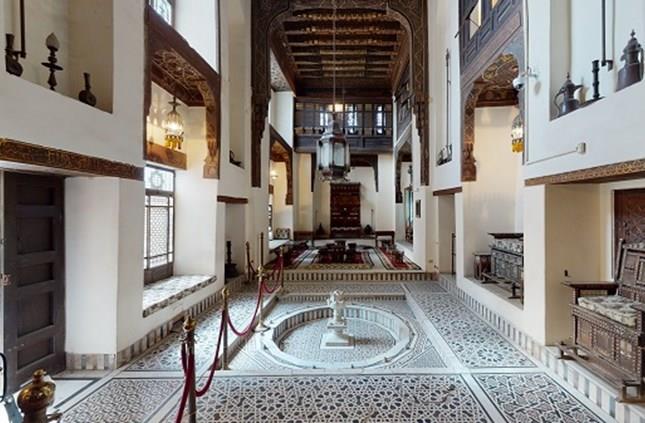
The Story Behind Gayer-Anderson Museum In Cairo - Dailynewsegypt
Bayt al-Kiritliya, with its wooden mashrabiya (screened windows), is known for being a set for the 1977 James Bond film“The Spy Who Loved Me” by British director Lewis Gilbert.
The Museum is considered as one of the well-preserved residential buildings from the 17th century in Cairo and a manifestation of the majesty and grandeur of Islamic architecture. The museum was established in 1540, and some say it was built on a mountain on which the ark of Noah rested!
There are 29 halls in the museum, the most important of which are the Indian, Chinese, and Damascus halls, and each one of them is furnished in the style of the country it represents. In addition, there are newly built halls, such as“Gates of al-Kiritliya” and“Masterpieces of al-Kiritliya”.
The Museum consists of two houses dating to the Ottoman period (16th and 17th
centuries). The first house was built by scholar Abd al-Qadir al-Hadad in 947 AH/ 1545 AD. Lady Amina bint Salem later bought it. The second house belonged to Hajj Mohamed ibn Salem ibn Jilmam al-Jazar in 1041 AH/ 1631 AD. Different families lived in the house until a lady from Crete bought it, so the house was named Bayt al-Kiritliya. But who is Gayer-Anderson?
Gayer-Anderson
John Gayer-Anderson was an English army doctor who studied medicine in London. He joined the English military in 1904 and was deployed in Egypt in 1907.
In 1935, Gayer-Anderson submitted a request to the Assembly of Preserving Arab Antiquities to live in the two houses and to furnish them in the Islamic-Arabic style. He proposed to gather a collection of pharaonic, Islamic, and Asiatic antiquities. These antiquities would belong to the Egyptian people following his death or when he left Egypt permanently. The assembly agreed. When Anderson left the house in 1942, the two houses came into the possession of the Assembly of Preserving Arab Antiquities, which converted the building into the Gayer Anderson Museum.
Inside the museum
Gayer-Anderson collected many Islamic and Pharaonic artefacts. He also spent a significant portion of his income on Islamic-inspired furniture. Gayer-Anderson decorated the rooms in a variety of oriental styles and filled them with objects from his travels. In addition to objects from Iran and Turkey, he also has Egyptian (both ancient and historic) items, as well as a collection of paintings and drawings done by 20th century artists.
There are 29 halls in the museum, all of which have a view of the house's courtyard and fountain, which was once connected to a romantic myth that in moonlit evenings, a man can see a reflection of his beloved's face in its water. Salamlek Hall, the men's council, was like a guesthouse. Haramlek Hall was the ladies section in the house, where no men are allowed. There are other halls representing many civilizations, the most well-known of which are the Indian, Chinese, and Damascus halls.
The main hall in the museum is the reception hall, which consists of marble tables decorated with paintings of fruits, flowers, and drinks. There is also another reception hall that has no ceiling, and includes copper vessels dating back to the 14th and 17th centuries, in addition to a large room supported by four columns that was reserved for women.
The museum features a collection of distinctive, wonderful, and unique paintings by Egyptian and international artists, including Mohamed Naji, Mahmoud Saeed, and Amy Nemer. Mohamed Ali Tawfiq drew a memorable picture in the museum in 1936. Additionally, paintings by Sperling and Thomas Gayer-Anderson are featured.
The museum has a unique wing with many Pharaonic antiquities, like the mask of Queen Nefertiti and ancient statues like the Pharaonic cat, as well as a drawing room with many rare paintings and an Indian antiquities pavilion with tools for yoga so visitors can experience some mental calmness.
The museum hosts a puzzle of theme-decorated rooms: the Persian room has exquisite tiling, the Damascus room has lacquer and gold, whereas in other parts of the museum, you'll find decorated ceiling beams and carpet-covered alcoves.
Location and tickets
The museum is located in Ahmed Ibn Tulun Square, in the Sayyidah Zeinab neighbourhood, and it is considered one of the most important tourist attractions in Egypt.
The museum opens everyday from 9 am to 5 pm. The ticket prices are EGP 60 for foreign adults, EGP 30 for foreign students, EGP 10 for Egyptian\ Arab adults, and EGP 5 for Egyptian\ Arab students.

Legal Disclaimer:
MENAFN provides the
information “as is” without warranty of any kind. We do not accept
any responsibility or liability for the accuracy, content, images,
videos, licenses, completeness, legality, or reliability of the information
contained in this article. If you have any complaints or copyright
issues related to this article, kindly contact the provider above.























Comments
No comment